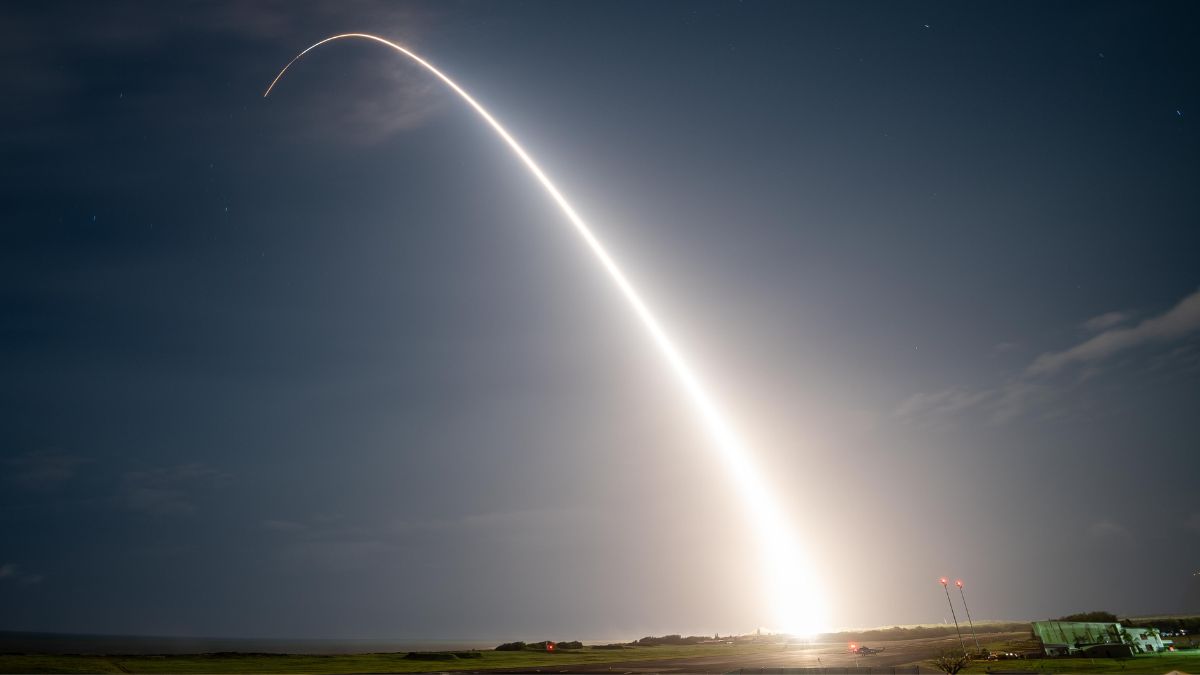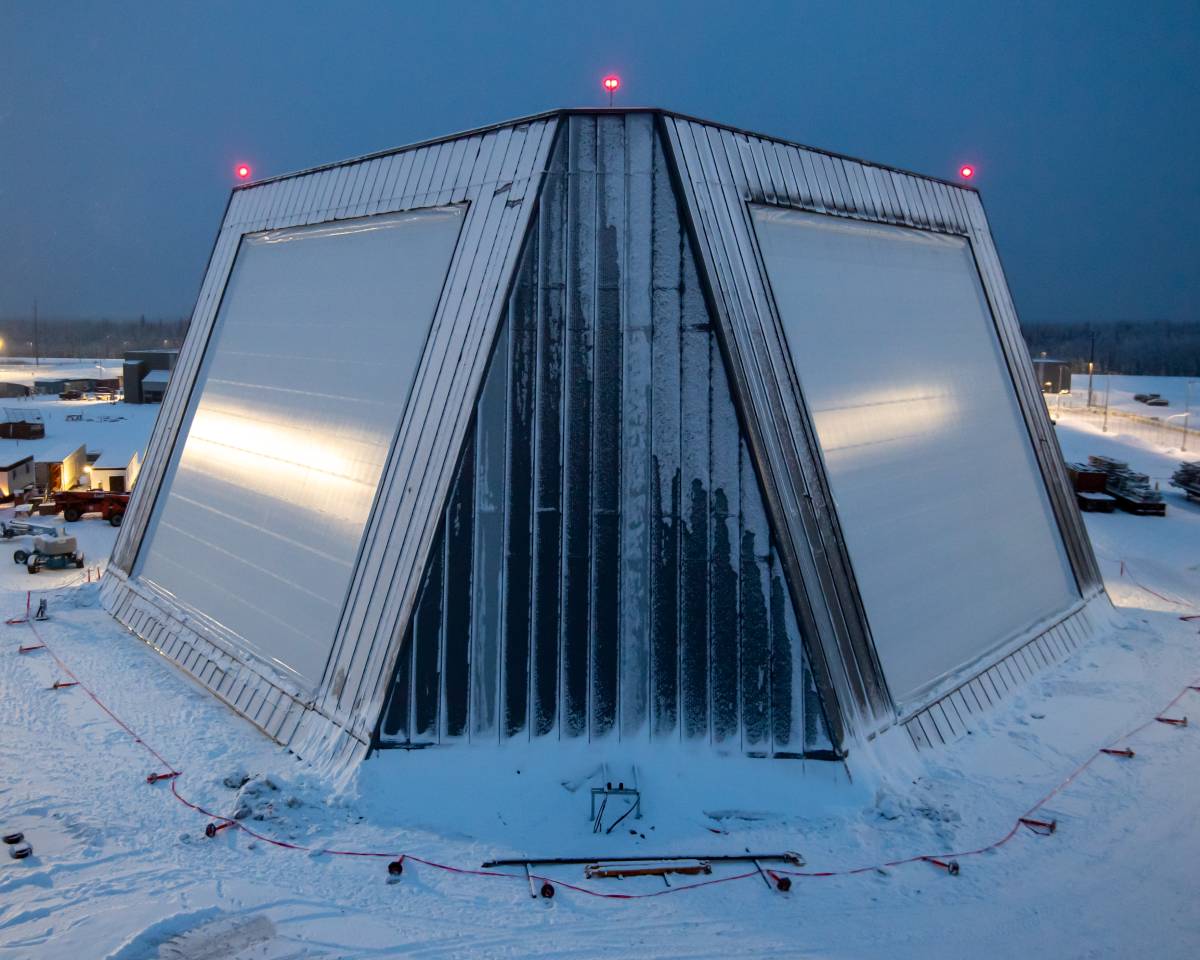 A medium range ballistic missile target is launched from the Pacific Missile Range Facility in Kauai, Hawaii, as part of the U.S. Missile Defense Agency’s Flight Test Aegis Weapon System 31 Event 1a, held on March 30, 2023 in cooperation with the U.S. Navy. (Source: Mark Wright/Missile Defense Agency)
A medium range ballistic missile target is launched from the Pacific Missile Range Facility in Kauai, Hawaii, as part of the U.S. Missile Defense Agency’s Flight Test Aegis Weapon System 31 Event 1a, held on March 30, 2023 in cooperation with the U.S. Navy. (Source: Mark Wright/Missile Defense Agency)
WASHINGTON — Military officials often emphasize the importance of a “full spectrum” approach to missile defense across all domains and all timelines, from left of launch deterrence and intelligence gathering to right of launch detection, warning, tracking, interception and defeat.
While the so-called “kill phase” of missile defense is critical, recent events demonstrate that defeating low-cost missiles with multimillion-dollar interceptors is not sustainable. There is growing recognition of the need for technology innovation, from directed energy to enhanced sensing and integration between the land, sea, air and space-based layers of the enterprise.
“The defensive interceptor piece is only one piece of the puzzle,” said Dr. John Plumb, U.S. Assistant Secretary of Defense for Space Policy, during a keynote at the NDIA’s Missile Defense Symposium in Washington, D.C. “We need to think about the whole problem set.”
Proliferating Space Defenses
Space has long been critical to the U.S. missile defense enterprise. That was made clear in April 2023, when planning and operational support for transregional missile defense was formally transferred to U.S. Space Command. Yet, despite decades of program development and billions of dollars of investment, there is still a gap between deployed capabilities and the level of persistent missile warning, missile tracking (MW/MT) demanded by military and policy leaders.
There are signs that the gap is beginning to close as a result of the development, testing and scheduled deployment of a multi-orbit MW/MT architecture in support of terrestrial systems.
“The thing that we need to do is proliferate,” said Undersecretary of Defense for Research and Engineering Heidi Shyu referring to the need for more MW/MT spacecraft on orbit.
In February, the U.S. Missile Defense Agency (MDA) successfully launched two of its Hypersonic and Ballistic Tracking Space Sensor (HBTSS) satellites into low Earth orbit, along with four other missile tracking spacecraft developed by the Space Development Agency (SDA). The SDA tracking satellites are reportedly returning data and actively scanning global hot spots.
As significant as this launch was, Shyu noted that the limited number of satellites is an inherent constraint. “It’s not good enough to have a ‘twosie,’” she said. “We need a lot more satellites than a ‘twosie.’”
A Multi-Orbit Roadmap
HBTSS will complement the missile tracking layer of the SDA’s Proliferated Warfighter Space Architecture (PWSA), which will consist of roughly 100 satellites in LEO when fully deployed. Space-based missile tracking will also include roughly 27 satellites in medium Earth orbit (MEO) as well as legacy systems—and their successors—operating in GEO and highly elliptical orbits (HEO). The multiple orbits allow for a broader scope of sensor data, more timely data collection and transmission, and a more resilient, survivable architecture.
SDA estimates the first operational LEO MW/MT satellites, or Tranche 1, will begin launch in April 2025 and will establish an initial warfighting capability. Improvements in sensor sensitivity, targeting and other capabilities will be incorporated into spacecraft deployed in future Tranches.
In MEO, Space Systems Command and SDA are currently collaborating on the first of three Epochs of MW/MT, which will consist of nine satellites in two orbital planes. Those Epoch 1 satellites will provide initial regional capabilities and are scheduled for launch in late FY 2026 or early FY 2027. The completed constellation will have 27 satellites.
In GEO and HEO, the Overhead Persistent Infrared (OPIR) satellites and Space Based Infrared System (SBIRS) continue to offer the most reliable coverage for early warning missile launch and tracking. However, they were not designed for today’s most pressing threats: maneuvering, non-ballistic and low-altitude hypersonic weapons. SBIRS is scheduled to be succeeded by the Next Generation Overhead Persistent Infrared satellite system by the end of the decade.
Integrating Ground and Space Sensors
Just as the space layer is the eye in the sky for the missile defense enterprise, terrestrial sensors are also feeding back into the national security space enterprise.
In April, MDA officially took over the Long Range Discrimination Radar (LRDR) at Clear Space Force Station in Alaska from contractor Lockheed Martin. It was a significant step toward operationalizing the S-band radar system, developed to search, track and discriminate between live missile threats and decoys. Earlier this year, LRDR proved its merit in collecting data for space domain awareness. Today, the U.S. Space Force and MDA are working to formally declare LRDR’s expanded mission in support of monitoring on-orbit threats and resident space objects. MDA Director Lt. Gen. Heath Collins recently noted the ground-based radar in Alaska will “bring enormous space domain awareness capability to our Space Force and to our country.”
 This image from October 26, 2021, shows the Long Range Discrimination Radar (LRDR) at Clear Space Force Sation, Alaska. LRDR is a multi-mission, multi-face radar designed to provide search, track and discrimination capability in support of homeland defense. (Source: Missile Defense Agency)
This image from October 26, 2021, shows the Long Range Discrimination Radar (LRDR) at Clear Space Force Sation, Alaska. LRDR is a multi-mission, multi-face radar designed to provide search, track and discrimination capability in support of homeland defense. (Source: Missile Defense Agency)
The SPY-7 radar, which recently completed its first live tracking event for the Japanese Navy will also have a mission to track space objects and debris. The system was developed using equipment and software from LRDR and U.S. officials have indicated that similar technologies could be deployed elsewhere in the Pacific in the future. MDA has also tested the AN/TPY-2 radar for space domain awareness within an operational environment, suggesting that sea-based Aegis destroyers could contribute to observing and tracking missile and non-missile threats on orbit.
Behind many of these recent tests was the Command Control Battle Management Communications (C2BMC) system, which has been described as “the glue” that holds together a globally distributed, multi-layered missile defense network. C2BMC is the integrating element, connecting planning, situational awareness and battle management across multiple domains. During recent tests, C2BMC effectively communicated with Space Command and Control, tasked LRDR and AN/TPY-2 and received reports back from the radars on resident space objects.
Moving Beyond Previous Best Efforts
Given the history of space-based missile defense in LEO, calls to proliferate beyond a few test satellites are prescient.
One of the earliest programs to use LEO for midcourse ballistic missile tracking was the “Star Wars-era” Space Brilliant Eyes program conceived by the Strategic Defense Initiative. The program was originally designed to use low Earth-orbiting satellites to image and detect early missile launches using infrared heat signatures. Brilliant Eyes was canceled in 1994 and revived shortly after as the SBIRS-low. By the time the concept was operationalized, it was renamed the Space Tracking and Surveillance System (STSS). Originally envisioned as a 20-30-satellite constellation, STSS produced two demonstration satellites that were launched in 2009 and collected data through 2021 before being deactivated. The program was succeeded by HBTSS.
Unlike previous attempts, today’s architectures are bolstered by a more advanced commercial space sector, increased commercial-government collaboration, lower-cost launch and new models for space acquisition. There is also renewed urgency among Pentagon leadership to fund and field defensive capabilities at a pace that matches the threat.
“We need to go faster. We need to think bigger as we move forward,” said Collins. “The threat is not holding still.”
Explore More:
Podcast: Space Development Agency Drives Disruptive Acquisition
Countering Hypersonics from Space: Multi-Orbit Missile Warning, Missile Tracking
AI Underpins the Pentagon’s Space Ambitions
NGA Veteran Discusses the Future of Commercial Space in Military Operations
